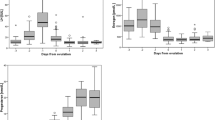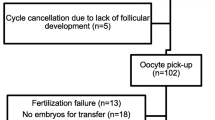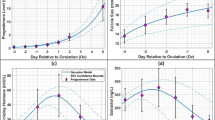Abstract
Purpose : To investigate the relative power of HCG, estradiol, and progesterone determinations in the prediction of pregnancy outcome after IVF. These prognostic hormonal factors were studied as single and combined predictors.
Methods : Serum concentrations of β-HCG, progesterone, and estradiol were measured 12–13 days after embryo transfer (study point 1) and 7 days later (study point 2) in a series of 20 consecutive infertile patients having a first-trimester spontaneous clinical abortion after an IVF-embryo transfer cycle. As a control group (n=60), the next three IVF-embryo transfer cycles resulting in an ongoing pregnancy after each miscarried IVF cycle in our assisted reproduction program was used. The discrimination attained between the two study groups (ongoing pregnancies and miscarriages) was evaluated by logistic regression and receiver operating characteristic (ROC) curve analysis.
Results : Mean hormone concentrations at study points 1 and 2 were higher in the ongoing pregnancy than in the abortion group. Regarding pregnancy outcome the percentage increment of HCG serum levels (≥1321%), with an accuracy (predictive value of pregnancy outcome) of 81.2% (sensitivity 98%, specificity 50%), had the best prognostic reliability but no significant differences were found when this parameter was compared with the predictive value of HCG concentration (≥72 IU/l) at study point 1 (diagnostic accuracy 80.5%; sensitivity 70%; specificity 80%). When ROC analysis was used, the best predictor of ongoing pregnancy according to the AUCROC was HCG concentration at study point 2 but again no significant differences were found when this parameter was compared with the predictive value of HCG serum levels at study point 1. A multiple marker strategy did not help distinguish viable from nonviable pregnancies.
Conclusion : A single, early (days 12–13 after embryo transfer) HCG quantitative serum measurement in IVF cycles not only is diagnostic but also has good predictive value for pregnancy outcome.
Similar content being viewed by others
REFERENCES
Gerhard I, Runnebaum B: The endocrinology of pregnancy. In Gynecological Endocrinology and Reproductive Medicine, B Runnebaum, T Rabe (eds), Berlin, Springer-Verlag, 1997, pp 344–417
Hahlin M, Wallin A, Sjoblom P, Lindblom B: Single progesterone assay for early recognition of abnormal pregnancy. Hum Reprod 1990;5:622–626
Kadar N, DeCherney AH, Romero R: Receiver operating characteristic (ROC) curve analysis of the relative efficacy of single and serial chorionic gonadotropin determinations in the early diagnosis of ectopic pregnancy. Fertil Steril 1982;37:542–547
Ludwig M: Pregnancy and Birth after Assisted Reproductive Technologies. Berlin, Springer, 2002
Confino E, Demir RH, Friberg J, Gleicher N: The predictive value of hCG beta subunit levels in pregnancies achieved by in vitro fertilization and embryo transfer: An international collaborative study. Fertil Steril 1986;45:526–531
Deutinger J, Neumark J, Reinthaller A, Riss P, Muller-Tyl E, Fischl F, Bieglmayer C, Janisch H: Pregnancy-specific parameters in early pregnancies after in vitro fertilization: Prediction of the course of pregnancy. Fertil Steril 1986;46:77–80
Heiner JS, Kerin JF, Schmidt LL, Wu TC: Can a single, early quantitative human chorionic gonadotropin measurement in an in vitro fertilization–gamete intrafallopian transfer program predict pregnancy outcome? Fertil Steril 1992;58:373–377
Schmidt LL, Asch RH, Frederick JL, Rojas FJ, Stone SC, Balmaceda JP: The predictive value of a single beta human chorionic gonadotropin in pregnancies achieved by assisted reproductive technology. Fertil Steril 1994;62:333–338
Fridstrom M, Garoff L, Sjoblom P, Hillensjo T: Human chorionic gonadotropin patterns in early pregnancy after assisted reproduction. Acta Obstet Gyencol Scand 1995;74:534–538
Glatstein IZ, Hornstein MD, Kahana MJ, Jackson KV, Friedman AJ: The predictive value of discriminatory human chorionic gonadotropin levels in the diagnosis of implantation outcome in in vitro fertilization cycles. Fertil Steril 1995;63:350–356
Al-Ramahi M, Perkins S, Claman P: Serum progesterone in predicting pregnancy outcome after assisted reproducvie technology. J Assist Reprod Genet 1999;16:117–120
Bjercke S, Tanbo T, Dale PO, Morkrid L, Abyholm T: Human chorionic gonadotrophin concentrations in early pregnancy after in-vitro fertilization. Hum Reprod 1999;14:1642–1646
Poikkeus P, Hiilesmaa V, Tiitinen A: Serum HCG 12 days after embryo transfer in predicting pregnancy outcome. Hum Reprod 2002;17:1901–1905
Urbancsek J, Hauzman E, Fedorcsak P, Halmos A, Dévényi N, Papp Z: Serum human chorionic gonadotropin measurements may predict pregnancy outcome and multiple gestation after in vitro fertilization. Fertil Steril 2002;78:540–542
Dor J, Rudak E, Rotmench S, Levran D, Blankstein J, Lusky A, Nebel L, Serr DM, Mashiach S: The role of early post-implantation beta-HCG levels in the outcome of pregnancies following in-vitro fertilization. Hum Reprod 1988;3:663–667
Yamashita T, Okamoto S, Thomas A, MacLachlan V, Healy DL: Predicting pregnancy outcome after in vitro fertilization and embryo transfer using estradiol, progesterone, and human chorionic gonadotropin beta-subunit. Fertil Steril 1989;51:304–309
Chen CD, Ho HN, Wu MY, Chao KH, Chen SU, Yang YS: Paired human chorionic gonadotrophin determinations for the prediction of pregnancy outcome in assisted reproduction. Hum Reprod 1997;12:2538–2541
Sugantha SE, Webster S, Sundar E, Lenton EA: Predictive value of plasma human chorionic gonadotrophin following assisted conception treatment. Hum Reprod 2000;15:469–473
Bustillo M, Stern JJ, King D, Coulam CB: Serum progesterone and estradiol concentrations in the early diagnosis of ectopic pregnancy after in vitro fertilization–embryo transfer. Fertil Steril 1993;59:668–670
Balasch J, Vidal E, Peñarrubia J, Casamitjana R, Carmona F, Creus M, Fbregues F, Vanrell JA: Suppression of LH during ovarian stimulation: Analysing threshold values and effects on ovarian response and the outcome of assisted reproduction in down-regulated women stimulated with recombinant FSH. Hum Reprod 2001;16:1636–1643
Gold R, Azem F, Wagman I, Amit A, Lessing J: Does ICSI affect early serum beta-HCG in pregnancies achieved after IVF? Hum Reprod 2000;15:1221–1224
Hanley JA, McNeil BJ: The meaning and use of the area under receiving operating characteristic (ROC) curve. Radiology 1982;143:29–36
Liu HC, Kreiner D, Muasher SJ, Jones G, Jones H Jr, Rosenwaks Z: β-human chorionic gonadotropin as a monitor of pregnancy outcome in in vitro fertilization–embryo transfer patients. Fertil Steril 1988;50:89–94
Author information
Authors and Affiliations
Rights and permissions
About this article
Cite this article
Carmona, F., Balasch, J., Creus, M. et al. Early Hormonal Markers of Pregnancy Outcome After In Vitro Fertilization and Embryo Transfer. J Assist Reprod Genet 20, 521–526 (2003). https://doi.org/10.1023/B:JARG.0000013654.85531.ac
Issue Date:
DOI: https://doi.org/10.1023/B:JARG.0000013654.85531.ac




